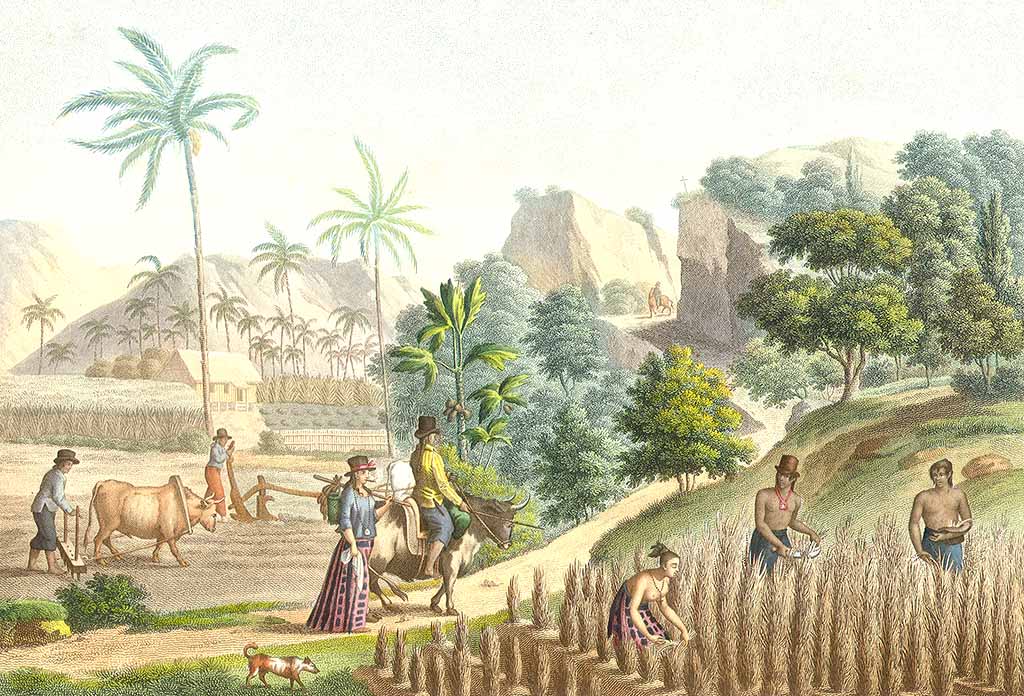
Upper class and lower class
Under Spanish colonial rule, the introduction of Spanish customs, social systems and land tenure disrupted traditional practices of land ownership and social class structure of the Chamorro/CHamoru people. Previously, traditional CHamoru society was divided into two castes with three distinct social classes. The higher caste consisted of the upper class matao and the middle class acha’ot. The lower caste consisted of the lower class manachang. In the years of Spanish administration, male primogeniture replaced the matrilineal system of inheritance. A new land ownership system was introduced which included the taking of land by the Spanish government for official purposes. Although CHamorus still held onto their communal ancestral lands, a new social order developed with distinct social class divisions known as mannakhilo’ and mannakpåpa’.
The mannakhilo’, or “high people” emerged from the principalia class, a class which replaced the upper class chamorri in traditional CHamoru society. The principalia were essentially CHamoru leaders who had converted to Christianity, and who were given civic duties and placed in positions within the Spanish government. Because the Spanish colonial administrators wanted to encourage the use of Spanish over CHamoru, these public offices were given only to those who spoke Spanish. CHamorus from the lower classes, therefore, were motivated to learn Spanish, as they saw this as an opportunity to advance their social status and obtain prestige over the upper class CHamorus who could not speak it. Subsequently, the chamorri class was replaced by the principalia class.
From the principalia class emerged a small group of elite, property-owning families who were descendants of CHamoru nobility that had united with the Spanish. These were the mannakhilo’—a privileged group of about 12 families that lived primarily in the village of Hagåtña in mamposteria (coral masonry) constructed houses. They adopted Filipino and Spanish styles of dress and manners, and although they spoke Spanish, they continued to speak CHamoru at home. They intermarried with the Spanish and had become mestizos (or mestisu), or of mixed heritage. They owned most of the private land, and donated substantial amounts to the Catholic Church. They formed intimate bonds with the Catholic priests and socialized with Spanish administrators. The mannakhilo’ refused to associate with the mannakpåpa heir lands. The upbringing of children was strict, with private tutors and arranged marriages to other sons and daughters within the upper class.
During the American era, the influence of the mannakhilo’ in government was diminished. According to Laura Thompson, the arrival of the naval government introduced a new economic system and compulsory education in public schools which allowed for members of the lower classes to attain wealth, education and prestige in competition with the upper class. In addition, the Americans formed their own social clubs that excluded the CHamoru elites, so although the mannakhilo’ remained the largest landowners in Guam, they did not have the same kind of influence or exclusivity that they had enjoyed under Spanish rule.
The mannakpapa’ represented the least privileged and the poorest population on Guam during the Spanish era. Predominantly CHamoru, the mannakpåpa’ did not own land. They were socially denigrated by the mannakhilo’, who refused to associate or intermarry with them. The mannakpåpa’ leased or worked the land owned by the mannakhilo’ or the Spanish government crown lands. In 1900, the first US naval governor, Captain Richard Leary, eliminated the practice of the mannakpapa’ paying debts to the mannakhilo’ with labor.
Whereas traditional social order among the CHamorus had depended on the social ranking of matrilineal clans, the order under Spanish colonization was based on affinities with the ruling Spanish administrators and officials of the Catholic Church. It is suggested, however, that the mannakpåpa’ and the mannakhilo’ classes represent the extreme social positions in CHamoru society—the elite and the poor. Indeed, the majority of the population was comprised of a middle class, who fell somewhere in between these two extremes, and for which there is no CHamoru term.
Many of these families did have access to some of their ancestral lands, which had been passed on through the generations, though most still lived on the periphery of Hagåtña and in rural areas. They maintained small ranches or lanchos in which they grew fruits and vegetables, and raised animals for subsistence and barter. Most of their heavy work and other activities that involved communal labor such as house-building, harvesting or roof-thatching, was done by related households and paid for through feasts. Wealth in the form of money was not accumulated and basic food and material needs were met through trade with relatives.
For further reading
Brunal-Perry, Omaira. “Nineteenth-Century Spanish Administrative Development in the Province of Guam.” In Guam History: Perspectives. Volume One. Edited by Lee D. Carter, William L. Wuerch, and Rosa Roberto Carter. Mangilao: Richard F. Taitano Micronesian Area Research Center, University of Guam, 1997.
Hattori, Anne Perez. Colonial Dis-ease: U.S. Navy Health Policies and the Chamorros of Guam, 1898-1941. Pacific Islands Monograph Series 19. Honolulu: University of Hawai’i Press, 2004.
Thompson, Laura M. Guam and Its People. With a Village Journal by Jesus C. Barcinas. 3rd ed. New Jersey: Princeton University Press, 1947.
Rogers, Robert. Destiny’s Landfall: A History of Guam. Honolulu: University of Hawai’i Press, 1995.
